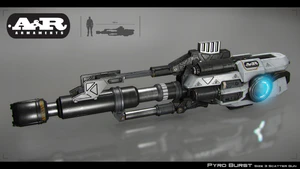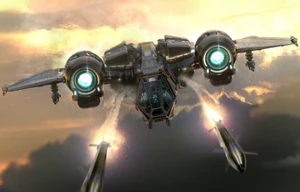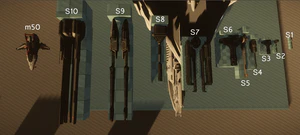
Weapons are the "teeth" of any ship seeking to attack others or defend themselves in the galaxy. A wide variety of weapons are available to pilots, each serving a different purpose. From traditional ballistic cannons, to hull-busting Torpedoes, starship pilots can wield an impressive array of firepower. The current weapon systems in Star Citizen, are ballistic weapon systems, energy weapon systems, and torpedoes / missiles.
Ballistic weapons

Ballistic weapons fire a solid or explosive projectile at a high speed, using the ship's limited store of ammunition. Ballistic weapons penetrate some percentage of enemy shields, somewhere between 20% to 60% depending on the shield, and deal the remaining damage directly to the hull. These projectile weapons do not use any energy and generate minimal to zero heat and signature on firing, but require ammunition to fire. The projectiles are generally slower than energy projectiles but can travel farther without loss of efficacy, and the rapid-firing types are ideal for point defense against missiles and torpedoes.
Within ballistic weapons, there are:
| Type | Fire rate | Projectile damage | Other properties |
|---|---|---|---|
| Ballistic Repeaters and Gatlings | High | Low | |
| Ballistic Cannons | Medium | Medium | |
| Ballistic Scatterguns | Low | High | Disperses in conical spread |
| Mass Driver Cannons | Low | High | |
| High Explosive Cannons | Low | High | Area of Effect Damage |
Energy weapons

Lasers focus light through lens arrays into a maser bottle. From there they are used to create neutron guns, masers, plasma, or other energy types to damage both shields and ships. The shield systems take damage from energy systems and once the shields are temporarily depleted, the energy weapons starts melting the targeted ship. Energy weapons generate a large amount of electromagnetic radiation, which can be exploited by a target ship's electronic warfare systems to return fire. The ease of fitting, supplying, and employing these weapons makes them a mainstay of any ship expecting to survive in prolonged combat.
Within energy weapons, there are:
| Type | Fire rate | Projectile damage | Other properties |
|---|---|---|---|
| Laser repeaters and laser beams | High | Low | |
| Laser cannons | Medium | Medium | |
| Neutron cannons and repeaters | Low | High | Very short range in all sizes |
| Plasma Scatterguns and Laser Scatterguns | Low | High | Disperses in conical spread |
| Tachyon cannons | Extremely high velocity and long range | ||
Distortion weapons

Distortion weapons are a unique derivative of energy weapons that inflict intense electrical discharges rather than thermal damage. Though they cannot harm hull integrity, these weapons are highly effective at depleting shields (including shield faces adjacent to the struck face) and, upon impacting unshielded hull, will degrade the ship's power systems and component performance, eventually leading to a complete power plant outage under sustained fire. Thus, distortion weapons enable a ship to be disabled without destroying it, and law enforcement officers, bounty hunters, and pirates routinely fit them to help seize vessels.
Within distortion weapons, there are:
| Type | Fire rate | Projectile damage | Other properties |
|---|---|---|---|
| Distortion repeaters | High | Low | |
| Distortion cannons | Medium | Medium | |
| Distortion Scatterguns | Low | High | Disperses in conical spread |
Missiles / torpedoes
Missiles are self-propelled, guided munitions systems that can deliver a variety of payloads to a target. Missiles are stored and fired from Pylons, which are characterized by the size of the rack, and the number and size of the missiles. For example, a Behring MSD-423 is a size 4 missile rack which can fire two size-3 missiles.
The two primary characteristics of a missile are its guidance system, and its payload

Guidance Systems
- Infrared (IR): Tracks locked-on ships by their heat and infrared emissions. An easier lock can be acquired on ships that are running "hot" by using more energy weapons or less heat-efficient components. Infrared guidance can be fooled by flares and can potentially lock on to an incorrect target with a similar heat signature
- Electromagnetic (EM): Tracks locked-on ships by their electromagnetic emissions which are released by electronic weapons and components. Careful energy management and efficient components can reduce a ship's EM signature to make locks more difficult. EM Missiles can be defeated with Chaff countermeasures
- Cross-Section (CS): Locks onto a ship's cross-section and appearance. Lock-on time is long compared to IR and EM locking, but more difficult to fool and unlikely to track the wrong target.
Payloads
- High Explosive (HE): An HE-equipped missile detonates directly on the targeted ship, causing severe damage to the ship's shields, hull, and impacted components.
- Electromagnetic Pulse (EMP): An EMP missile detonates on or near the targeted ship, causing significant damage to shields and potentially disabling major components on the ship, much like a distortion projectile weapon.
- Cluster Munition Explosive Projectiles (CM): An CM-equipped missile approaches the targeted ship and fires a cluster of submunitions that weakens the armour or shields, leaving the target vulnerable to the full payload that follows. (Example: the NOVP Rattler II)
Weapon mounts

Weapons come in different sizes which are standardized in the galaxy to allow pilots to pick and place weapons into specific sized ship hardpoints. These sizes are determined by the physical size of the weapon, as well as its relative power, resource usage, signature. Weapons operate on a similar system to other ship components; allowing for a certain level customization and design.[1]
Ship Weapon hardpoints are divided into several categories depending on what can be mounted to each:
- Weapons: Standard weapon hardpoints can mount a variety of direct-fire energy and ballistic weapons
- Turrets: Both remote and manned turrets mount to the same hardpoint, offering a much wider field of view and fire than a standard weapon, but usually requiring additional personnel to man it or AI systems to aim and fire.
- Ordnance: Torpedoes, missiles, and other explosive ordnance are mounted to missile racks on these hardpoints
- Utility and Other: These hardpoints are for utility items such as Stor-All boxes or EMP generators.

Shops
Star Citizen ship weapon shops list:
Common terms
References
- ↑ Comm-Link:Weapons Mount Updates. Transmission - Comm-Link